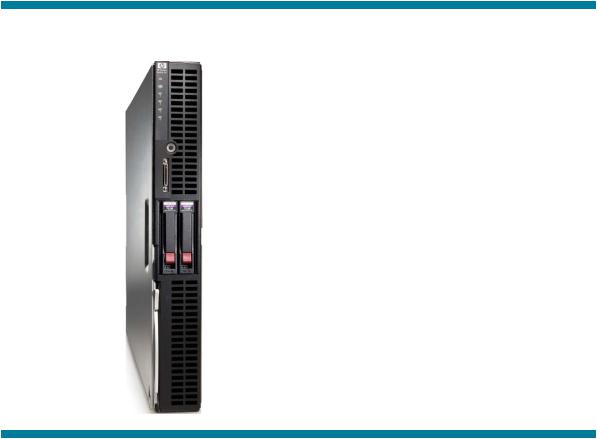HP BL685c G5 User Manual

Performance characterization of HP ProLiant BL685c G5 with Quad-Core AMD Opteron processors (2.3 GHz) in a 64-bit HP Server Based Computing environment
Executive summary............................................................................................................................... |
3 |
Audience ........................................................................................................................................ |
3 |
Introduction......................................................................................................................................... |
3 |
AMD Opteron processors ................................................................................................................. |
4 |
AMD Dual Dynamic Power Management ........................................................................................ |
5 |
Test methodology................................................................................................................................. |
6 |
Test tools......................................................................................................................................... |
7 |
More information ......................................................................................................................... |
7 |
User profiles .................................................................................................................................... |
7 |
Test scenarios .................................................................................................................................. |
8 |
Performance and scalability metrics ................................................................................................ |
8 |
Test topology....................................................................................................................................... |
9 |
Configurations ............................................................................................................................... |
10 |
HP SBC server summary.................................................................................................................. |
11 |
Performance test results....................................................................................................................... |
12 |
Perfmon values .............................................................................................................................. |
13 |
Canary times ................................................................................................................................. |
14 |
Test analysis summary ........................................................................................................................ |
15 |
Appendix A – HP BladeSystem............................................................................................................ |
16 |
HP BladeSystem c7000 enclosure .................................................................................................... |
16 |
Management ............................................................................................................................. |
17 |
Options..................................................................................................................................... |
17 |
HP BladeSystem c3000 enclosure .................................................................................................... |
17 |
Performance .............................................................................................................................. |
18 |
Management ............................................................................................................................. |
18 |
Options..................................................................................................................................... |
18 |
Appendix B – Using Microsoft Windows Server 2003 x64 Editions......................................................... |
19 |
Historical scalability limitations ........................................................................................................ |
19 |
More information ....................................................................................................................... |
20 |
Appendix C – SBC solution sizing ....................................................................................................... |
21 |
Online sizer tool ............................................................................................................................ |
21 |
For more information.......................................................................................................................... |
23 |

Executive summary
Important:
This document describes a performance characterization performed utilizing the HP 64-bit test harness, which incorporates a Microsoft® Office 2003 workload.
Test results cannot be compared directly with the results of tests performed using the 32-bit Office XPor Office 2003-based harness.
The HP ProLiant BL685c G5 server blade delivers uncompromising performance and expandability in a dense form factor. With up to four Quad-Core AMD Opteron™ processors, 64 GB of DDR2 memory, two hot plug serial hard drives, four integrated network adapters and three I/O expansion slots, the HP ProLiant BL685c G5 server blade can support the most demanding enterprise-class applications.
A four-socket1 HP ProLiant BL685c G5 server blade with the AMD Opteron Processor Model 8356 (2.3 GHz) can provide optimal support for up to the following numbers of users (as described in Table 2) in a 64-bit HP Server Based Computing (SBC) environment:
Heavy Users |
301 |
Medium Users |
444 |
Light Users |
544 |
|
|
Since the kernel memory constraints that limit scalability in a 32-bit HP SBC environment have been removed, this performance characterization demonstrates that customers can expect to fully utilize the resources of this server in a 64-bit environment, even when running their 32-bit applications.
Testing performed in March 2008 is described.
Audience
This performance characterization is intended primarily for IT professionals planning HP SBC solution deployments. The performance and sizing information provided herein is designed to help customers estimate the number of HP ProLiant BL685c G5 server blades required for a particular environment.
Introduction
The HP ProLiant BL685c G5 server blade (shown in Figure 1) is ideal for multi-threaded, multi-tasked environments, high-performance computing, and HP SBC.
Note:
This server blade is deployed within an HP BladeSystem enclosure. For more information, refer to Appendix A – HP BladeSystem.
1 Four-processor, also known as 4P
3

Figure 1. HP ProLiant BL685c G5 server blade
AMD Opteron processors
The HP ProLiant BL685c G5 server blade supports up to four Quad-Core AMD Opteron 8300 Series processors. This native quad-core processor delivers the following benefits:
•Outstanding performance
The Quad-Core Opteron processor is designed for optimal multi-threaded application performance. Its native quad-core implementation features four cores on a single die for more efficient data sharing, while the enhanced cache structure and integrated memory controller can sustain application throughput. This processor provides outstanding processing power and, together with its performance-per-watt enhancements, can improve IT responsiveness while maintaining data center costs.
•Enhanced power efficiency
Thanks to Enhanced AMD PowerNow!™ technology and the introduction of AMD CoolCore™ technology, Quad-Core Opteron processors are very power-efficient, helping to reduce power needs and cooling costs in the data center.
(For more on power management enhancements, see AMD Dual Dynamic Power Management.)
•Optimal virtualization
Featuring AMD Virtualization™ (AMD-V™) technology with nested paging acceleration, Quad-Core Opteron processors can accelerate the performance of virtualized applications and improve efficiency when switching between virtual machines; as a result, customers can typically host more virtual machines and users per system, maximizing the consolidation and power-saving benefits of virtualization.
4

•Investment protection
By leveraging AMD’s Common Core Strategy and Same Socket Technology, Quad-Core Opteron processors can minimize changes to the customer’s software and data center infrastructure, protecting IT investments and simplifying management.
AMD Dual Dynamic Power Management
Dual Dynamic Power Management functionality allows each processor to maximize the power-saving benefits of Enhanced AMD PowerNow! without compromising performance, reducing idle power consumption and enabling per-processor power management in multi-socket systems to further reduce power consumption.
By powering core and memory controller voltage planes independently, Dual Dynamic Power Management can enhance both performance and power management.
Benefits include:
•Increased performance
The memory controller is able to run at a higher frequency, helping to reduce memory latency and thus improving application performance.
•Improved power management
By operating independently from the memory controller, the cores in a Quad-Core Opteron processor can exploit the power savings offered by Enhanced PowerNow! more often, resulting in reduced power and cooling bills. In addition, the processor reduces power to the northbridge2 when memory is not in use, while continuing to provide full power to the cores.
The following sections of this paper describe the testing performed by HP to characterize the performance and scalability of an HP ProLiant BL685c G5 server blade in a 64-bit HP SBC environment.
Note:
A 64-bit HP SBC environment eliminates the kernel memory constraints that can limit server scalability in a 32-bit HP SBC environment. For more information, refer to Appendix B – Using Microsoft Windows Server 2003 x64 Editions.
2 Or memory controller hub (MCH)
5

Test methodology
HP continues to upgrade existing HP ProLiant servers and introduce new servers to meet particular business needs. To help customers select the appropriate server for their particular HP SBC environment, HP publishes this and other performance characterizations so that you can compare individual server performance and scalability.
This section describes how HP determined the optimal number of users supported by an HP ProLiant BL685c G5 server blade with the Opteron Processor Model 8356 (2.3 GHz) – henceforth referred to as the HP ProLiant BL685c G5 server blade – in a 64-bit test harness.
Important:
As with any laboratory testing, the performance metrics quoted in this paper are idealized. In a production environment, these metrics may be impacted by a variety of factors.
HP recommends proof-of-concept testing in a non-production environment using the actual target application as a matter of best practice for all application deployments. Testing the actual target application in a test/staging environment identical to, but isolated from, the production environment is the most effective way to characterize system behavior.
This section provides more information on test tools, user profiles and test scenarios.
6

Test tools
To facilitate the placement and management of simulated loads on an HP SBC server, HP used Terminal Services Scalability Planning Tools (TSScaling), a suite of tools developed by Microsoft to help organizations with Microsoft Windows® Server 2003 Terminal Server capacity planning.
Table 1 describes these tools.
Table 1. Components of TSScaling
Component |
|
Description |
|
|
|
Automation tools |
Robosrv.exe |
Drives the server-side of the load simulation |
|
|
|
|
Robocli.exe |
Helps drive the client-side of the load simulation |
|
|
|
Test tools |
Qidle.exe |
Determines if any scripts have failed and require |
|
|
operator intervention |
|
|
|
|
Tbscript.exe |
A script interpreter that helps drive the client-side load |
|
|
simulation |
|
|
|
Help files |
TBScript.doc |
Terminal Server bench scripting documentation |
|
|
|
|
TSScalingSetup.doc |
A scalability test environment set-up guide |
|
|
|
|
TSScalingTesting.doc |
A testing guide |
|
|
|
More information
•Roboserver (Robosrv.exe) and Roboclient (Robocli.exe): Terminal Server capacity planning
•TSScaling: Windows Server 2003 Terminal Server Capacity and Scaling
User profiles
To simulate typical workloads in this environment, HP used scripts based on the Heavy, Medium, and Light User profiles described in Table 2.
Table 2. User profiles incorporated into the test scripts
User class |
Activities |
|
|
Heavy User |
Heavy Users (also known as Structured Task Workers) tend to open multiple applications |
|
simultaneously and remain active for long periods. Heavy Users often leave applications open |
|
when not in use. |
|
|
Medium User |
Medium Users (also known as Knowledge Workers) are defined as users who gather, add value |
|
to, and communicate information in a decision-support process. Cost of downtime is variable but |
|
highly visible. These resources are driven by projects and ad-hoc needs towards flexible tasks. |
|
These workers make their own decisions on what to work on and how to accomplish the task. |
|
Sample tasks include: marketing, project management, sales, desktop publishing, decision |
|
support, data mining, financial analysis, executive and supervisory management, design, and |
|
authoring. |
|
|
Light User |
Light Users (also known as Data Entry Workers) input data into computer systems. Activities |
|
include transcription, typing, order entry, clerical work and manufacturing. |
|
|
7
